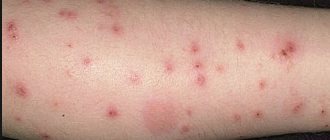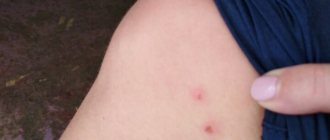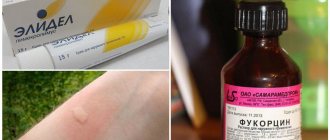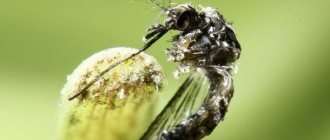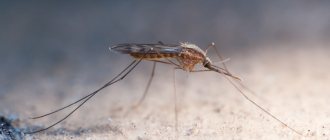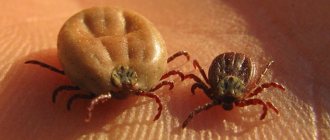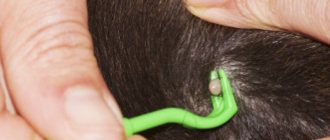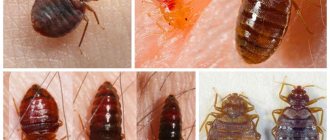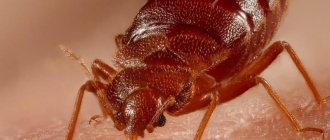How to remove bedbugs
The appearance of bedbugs in the house is always an unpleasant phenomenon that brings a lot of discomfort. Often the reason for the proliferation of these insects in the home is the person himself, who brings them on his things.
How to detect
In order to find out how to get rid of bed bugs, you first need to make sure that it is these parasites that have appeared in your home and are interfering with your life. The easiest time to identify bloodsuckers is at night – from 3 to 5 o’clock. The smell and body of a person attracts these insects, since their main food is blood. Once on the body, they pierce the skin and begin to suck out blood, while at the same time injecting painkillers.
During the day, parasites prefer to hide in corners near the sleeping area. It can be:
- cracks, joints, folds of upholstered furniture;
- housings of household appliances;
- carpets and paintings on the walls;
- wallpaper and cracks behind baseboards;
- clothes and shoes that are not worn;
- under the rugs.
Look for bloodsuckers in secluded areas that you rarely disturb during cleaning or life processes.
The main signs of bedbugs appearing in the house are:
- The appearance of 4-5 red bites on the body of residents that itch.
- The appearance of a smell that is similar to cognac, almonds or sour berries (when there are a lot of insects).
- Traces of vital activity of parasites - their eggs, excrement, traces of blood on bed linen, particles of chitin.
Harm to humans
The main danger of these arthropods is that they feed on human blood. They can retain pathogens of various dangerous diseases for a long time, in particular:
- hepatitis B of viral etiology;
- plague;
- tularemia;
- Q fever.
However, no cases of infection with these and other human viruses from bedbug bites were identified during the entire observation period.
Parasite bites bring a lot of discomfort to a person, since by biting at night, insects disrupt normal sleep and proper rest. This can subsequently cause not only problems in the functioning of the nervous system, but also affect the general physical condition.
Treatment of effects of exposure
There is no specific treatment for bites. Treatment boils down to eliminating the symptoms, since the resulting rashes usually go away on their own after 4-5 days:
- if itching occurs, wash the bite site with soap and water, this will reduce irritation and help prevent infection;
- lubricate the affected areas of the skin with antipruritic ointment or hydrogen peroxide 3-4 times a day;
- if a severe allergic reaction occurs, antihistamines are prescribed for 3-5 days;
- If the bite site begins to hurt, take painkillers.
How to poison bedbugs
One of the most effective ways to remove bedbugs is to contact special services that deal with the disinfestation of premises. Of course, you can try to remove parasites yourself, but such methods do not give 100% results.
There are several ways you can try to get rid of bloodsuckers on your own:
- Warming up the room to +48 degrees for 4-6 hours. Bedbugs cannot tolerate high temperatures, as this has a detrimental effect on them and their eggs.
- Bed bugs in sofas and other furniture can be killed by using a steam cleaner.
- Another method is to wash items at a temperature of at least 50 ℃.
- All surfaces can be treated with a vacuum cleaner, but it will not be possible to get rid of insects in hard-to-reach places in this way.
- The use of insecticides is the most common method of controlling parasites. However, when using such products yourself, you must be as careful as possible and be sure to follow safety rules.
However, all of the above remedies are unlikely to get rid of insects. How to get rid of bedbugs forever? You need to use professional tools. This work should only be performed by specialists.
Bed bugs
The bedbug or Cimex lectularius is a blood-sucking ectoparasite. The body length is 3-9 mm, the color is yellow-brown. It pierces the skin with the help of a special proboscis, and the jaws have 2 ducts, one of which is adapted for sucking blood, the second for releasing saliva into the wound. They bite at night from 3 to 8 am.
Features of the parasite:
The body has a strongly flattened shape, so it is difficult to crush the bug- They are nocturnal
- Up to 500 bites can be found on human skin in one night
- They bite only exposed parts of the body and are not able to bite through fabric.
- They live in upholstered and cabinet furniture, crevices, linen, clothes, under wallpaper and in books
- They live equally well both in dirt and in perfectly clean conditions.
- On a person’s clothes they are transferred to other houses and apartments
- Average life expectancy – 1 year
- Withstands temperatures up to 50 C
Harm to humans
Bedbug bites themselves are not dangerous for transmitting any diseases, although the possibility of transmission of tularemia, anthrax, brucellosis, and smallpox through the insect cannot be ruled out. Also, a bug bite does not cause pain.
But a significant skin rash, severe itching, allergies, unpleasant body odor, and unaesthetic appearance of the skin often bring psychological trauma to a person who, not knowing the cause of his condition, begins to look for terrible diseases within himself and withdraws into his problems. Thus, the consequences of a bedbug bite are physical and mental suffering for a person.
How to detect insects indoors?
- Brown-brown stains on bedding and underwear, which remain from insects accidentally crushed by humans.
- Accumulations of eggs, excrement and scales remaining after the bedbug molts in the grooves between parts of furniture, under furniture, in niches for linen of sofas and beds.
- Specific odor in the premises (in case of severe infection).
Symptoms of a bedbug bite
A person may not notice the symptoms of bedbug infestation for a long time or attribute the symptoms to other diseases (scabies, allergic dermatitis, etc.).
- Multiple small red spots on the body, resembling small pimples or mosquito bites. Traces of bed bug bites
- Slight swelling of the affected areas of the skin.
- Severe itching.
However, these symptoms are not always present. When biting, an adult bug secretes a special enzyme into the human skin, making its bite invisible both in sensation and appearance - there is no redness or itching. Vivid symptoms occur in people with a tendency to allergies, when premises are heavily infested, and also when young bedbugs bite them.
What do bed bug bites look like?
It is not difficult to distinguish bedbug bites from the bites of other insects. Typically this is:
multiple bites (50-100 or more). Although outwardly the bite sites are similar to a mosquito bite, in practice such a massive mosquito attack in a residential area is impossible;- a kind of bite path, i.e. red dots located one after the other at a distance of several mm to several cm. Unlike the passages of the scabies mite, the bedbug leaves such a path in one night, and the scabies mite - in several days.
Treatment of bedbug bites
There is no specific treatment for bedbug bites. Minor skin rashes resolve on their own within 3-4 days. Therapeutic measures are aimed at eliminating unpleasant symptoms and should be carried out in parallel with measures to combat bedbugs:
- Careful skin hygiene with detergents in the evening and morning.
- Lubricating the affected skin with hydrogen peroxide or antipruritic ointment (Fenistil) 3-4 times a day (see ointments for allergies)
- In case of a severe allergic reaction, take antihistamines for 3-5 days (Loratadine, Zyrtec, Telfast, see list of allergy pills).
How to get rid of bed bugs
The most effective is sanitary treatment of contaminated premises, which is carried out by an organization specializing in this. Very often, attempts to remove annoying insects on their own end with people simply getting rid of the infested furniture, however, this is not a guarantee that all individuals have left the living space.
Physical methods
- These include the effect of high temperature on parasites. Warming up the room for 6-8 hours at a temperature of +48 C guarantees the destruction of bedbugs and their eggs.
- At home, you can use a steam cleaner, the steam of which penetrates into hard-to-reach places, the seams of furniture upholstery, etc. This method also helps to disinfect clothes, linen, toys, etc. by heating them in dryers for about 20 minutes.
- Washing items at a temperature of at least 50 C is also effective.
Mechanical methods
This is the treatment of furniture and surfaces with a vacuum cleaner, after which the bag with parasites trapped there is destroyed. The effectiveness of the method is low due to the fact that bedbugs and their eggs may remain in places inaccessible for treatment.
Chemical methods
These include the use of insecticides, which should be used to treat furniture, cracks, baseboards, floors and other places in accordance with the instructions. The treatment should be carried out twice, the second time - two weeks after the first treatment, when young individuals can hatch from the surviving eggs.
Self-application of insecticides requires care and caution. No matter how safe insecticides are, you should not treat premises in the presence of children and pregnant women. You should strictly follow the instructions, especially the dosage of the drug, and also take personal measures to prevent poisoning.
The most effective insecticides:
GET liquid based on chlorpyrifos. Can be used in rooms where there are children. The effectiveness of the treatment provides protection against bedbugs for 6 months. The insecticide Dobrokhim Micro, which is similar in active substance, has the same properties.- Multicomponent insecticide Taran based on zetacypermethrin. The drug remains active for 2 months after treatment.
- Aerosol Raid based on cypermethrin, prallethrin and imiprothrin. Effective for 15 days.
- Boric acid, vinegar, and turpentine are also used in the fight against bedbugs, but their effectiveness is lower.
Natural Methods
These include the use of plants: tansy, fresh or dry wormwood, laid out in the most typical habitats of bedbugs - under furniture, in cracks, on the floor, etc. Treating rooms and furniture with a decoction of wild rosemary leaves also helps. These methods are safe for humans and can be used without leaving the premises.
Another natural method is to take contaminated furniture outside for several days, which is effective in sub-zero temperatures and in hot weather. Insects cannot withstand frost and direct sunlight, so they die within 24 hours. In addition, they are deprived of a power source, which accelerates their death.
They say that where cockroaches live, there are no bed bugs, since cockroaches are the latter's natural enemies. But this is not the best way to combat parasites - cockroaches, although they do not bite humans, carry various infections.
Ticks
Bed mite
- another type of parasite that can appear in the house and cause a lot of inconvenience. It is necessary to distinguish these insects from each other, as some may confuse them with bedbugs.
How to detect
Detecting a bed mite, or as it is also called a dust mite, is visually extremely difficult, since the parasite has dimensions from 0.1 to 0.5 mm. Like other harmful insects, they will definitely be residents of an untidy, cluttered apartment that is not cleaned and there is a lot of dust.
Dust and remains of human skin are the most favorable habitat.
Parasites can get into the house in several ways:
- Clinging to your clothes or belongings. If you sit on furniture that is infested with insects, you can easily bring them into your apartment.
- Pets also carry these insects on their fur.
- Through cracks, ventilation ducts, and socket openings, parasites can get to you from your neighbors.
Harm to humans
Due to the fact that you will not be able to see the dermatophagoid mite, you can determine its presence by the following symptoms:
- restless sleep;
- coughing attacks during sleep;
- skin rashes, itching, dryness;
- persistent cough and runny nose without signs of acute respiratory infections or acute respiratory viral infections;
- tearing, redness and swelling of the eyelids, inflammation of the eye mucosa;
- sometimes – increased body temperature and difficulty breathing with wheezing.
All these are signs of an allergic reaction to the waste products of these parasites, since a person has maximum contact with them during the night’s rest.
House dust mites pose a serious threat to life. One of these is a severe allergic reaction called Quincke's edema, as it threatens a person with suffocation and subsequent death.
Treatment of effects of exposure
In order to get rid of the symptoms of an allergic reaction to synanthropes, you need to immediately seek help from a dermatologist. The doctor will prescribe medications for treatment that will relieve itching, redness, swelling, and skin inflammation.
How to remove ticks
You can get rid of them in several ways:
- Thoroughly vacuum both sides of the mattress you are sleeping on.
- All bedding should be washed at a high temperature, preferably around 90℃.
- In some cases, it is better to get rid of the pillow and mattress and update your bedding.
- It is necessary to regularly open windows for ventilation and carry out wet cleaning. Use disinfectants such as Mister Muscle or Domestos.
Below is a comparison table to summarize the information. It clearly shows how and how bed bugs differ from bed mites.
| Comparison options | Bug | Mite |
| Size, mm | 1,5-2 | 0,1-0,5 |
| Does it bite or not? | Yes | No |
| Main habitats | sleeping places | sleeping places |
| What does it eat? | blood | dead epidermis |
| Harm to humans | bites, allergies | allergy |
| Treatment of effects of exposure | like allergies | like allergies |
| Effective methods of struggle | pest control service | pest control service |
Bed mites
Where do such inconvenient neighbors come from that can harm the body? Oddly enough, they can appear in ordinary dust, feathers or fluff.
It is almost impossible to predict their appearance. But if they appear, it can be immediately noticed by the condition of the person who is beginning to develop an allergy.
Dust mites are not large in size. They can easily live in a large army on 1 gram of dust. Such parasites cannot tolerate temperatures that are too high or too low.
Ideal conditions for their habitat are between +20 and +25 degrees. Their main source of nutrition is human dandruff, which forms on the skin. That is why they can appear on his body.
When choosing small corner sofas, you should pay attention to their configuration, color scheme, coating texture, availability of additional storage space, design, quality of materials used, frame strength indicators and cost.Due to the fact that an accordion sofa with an orthopedic mattress must constantly bend when folded, it is very difficult to equip it with spring blocks. Read about the design of the sofa and the choice of mattresses for it here.
Bed tick bites can cause various forms of allergies in humans. As a rule, the first signs of this disease include redness of the throat, increased sensitivity of the eyes, cough, and the appearance of itchy redness on the skin.
All these factors indicate that unpleasant neighbors have settled in your bed. The only consolation in this situation may be that these insects are not capable of causing serious illness in humans, and it is very easy to get rid of them.
How to remove bedbugs or ticks from a bed and sofa
Questions about how to remove bedbugs from a sofa or bed ticks from a mattress are the most pressing after the owners have discovered an unpleasant neighborhood. Of course, you can try to get rid of parasites using various traditional methods. But remember that none of them provides a complete guarantee that the entire population has been exterminated.
If you notice that these unpleasant neighbors have appeared in your apartment, then the best way to deal with them is to call exterminators. In their work, they use only high-quality, and most importantly, safe for health preparations and know how to remove bedbugs from your home.
Thanks to modern technologies, it is possible to disinfest the most inaccessible places and remove absolutely all insects.
The latest cold fog technology involves finely dispersed spraying of drugs, as a result of which the poison:
- gets into all folds of furniture upholstery;
- penetrates into the wood itself from which the furniture is made;
- goes deep into the furniture filler;
- reaches all hidden places in the room.
Experts say that self-treatment of beds and sofas is not able to get rid of bed mites and bed bugs forever. Most likely, the insects will only leave their favorite places for a while and then return again. This is why you should entrust the fight against insects to specialists.
Watch a video on how to deal with dust mites.
How to get rid of furniture bugs and bed mites?
No one is safe from the appearance of blood-sucking insects in the house. The most famous and common parasites are furniture mites and bedbugs. They feed on the blood of warm-blooded creatures, going out to hunt in the dark. And if a person feels bedbug bites, then the ticks bite unnoticed.
However, after these bites, an allergic reaction accompanied by itching may develop. In order for the fight against parasites to be effective, it is very important to distinguish whether harmful small bed mites or house bugs have settled in your home.
The main differences between ticks and bedbugs
From a distance, bedbugs and ticks are very similar. But if you look closely, you can see that the representative of the Arachnida class has eight legs, while bedbugs have six.
Bed mites have impressive dimensions and can be up to 8 mm in size. Their cousins, dust mites, are quite difficult to detect due to their small size. Furniture bugs are nocturnal bloodsuckers, while linen mites feed on dead skin particles.
Bed bugs live in secluded dark places in the apartment. They can be found in furniture, under baseboards and wallpaper, in old things. House mites live in feather blankets, pillows, and blankets.
What do furniture bugs look like?
Popularly, these parasites are called bed bugs because they most often settle in beds and sofas to be closer to the victim.
The insect, measuring from 3 to 8 mm, can be dirty yellow to dark brown in color. It has a flattened body and a special proboscis on its head. This proboscis is divided into narrow and wide channels. From the narrow channel, saliva containing an anesthetic substance is injected into the wound, and blood is absorbed through the wide channel.
Even at the stage of larval development, glands secreting a special secretion develop on the back of the parasite. They produce an odor that is characteristic of bedbugs. The oblong curved eggs of blood-sucking insects are whitish in color. Depending on environmental conditions, the larvae may hatch within a few days or weeks.
The larvae differ from adult individuals in their lighter color and smaller size. They do not yet have a special anesthetic substance in their saliva, so the bites of young individuals are more sensitive.
Signs of furniture bugs
enter an apartment or house along with old furniture, pets or clothes after visiting guests. If a dysfunctional family lives in a neighboring apartment, then insects can migrate away from them through cracks or ventilation.
The fact that furniture bugs have appeared in the house can be determined by the following signs:
- Bites on the body after a night's sleep. Crawling along the body, the bug constantly bites, so after it the bites are located in the form of “paths”.
- Discarded chitinous covers.
- Dark experiments.
- A sharp, unpleasant odor reminiscent of coriander.
As soon as suspicions creep in that bedbugs have appeared in your home , you need to immediately inspect the possible places of their settlement:
- joints of upholstered and wooden furniture;
- curtains, mattresses, pillows, beds, clothing seams;
- behind skirting boards, torn wallpaper, paintings, books,
- under carpets and floor coverings,
- behind radiators, door jambs, under window sills.
Blood-sucking insects crawl out of their hiding places in search of prey only at night.
How dangerous are bedbug bites?
Bedbug bites resemble allergies or mosquito bites , so you may not immediately understand that parasites have appeared in your home. During the night, one individual makes up to seven punctures, which a sleeping person may not even feel. The marks left at the site of bedbug bites may not itch. You can find out that you were bitten by a bug by the nature of the skin injury. Red spots located one after another with a dark dot inside are bites of nocturnal blood-sucking insects.
What do bed bugs look like?
Currently, bed bugs are one of the least recognized household insects in the world. They can be confused with cockroaches, mites or lice. Since bed bugs can look different at different stages of their development, they are somewhat similar to other types of insects. Very often, it is not easy for a city resident to determine what kind of insect has entered his apartment, so there is a danger of allowing a colony of bedbugs to multiply. And this threatens with great difficulties and discomfort. This is why everyone should know what bedbugs look like. And if detected, immediately begin to fight against uninvited guests in order to protect yourself and your loved ones from bites at night.
Description of the appearance of a bed bug
Almost everyone has encountered bedbugs that live in parks and courtyards on some kind of vegetation. If you disturb such a bug, it almost instantly begins to emit a strong, pungent odor. In appearance, almost all bedbugs in nature are similar to the forest bug, which is familiar to everyone. Soldier bugs, tree bugs, agricultural bugs and even water striders have similar body structure. However, bed bugs are somewhat different in appearance from this general mass of insects of the same family. Due to the fact that this type of insect does not live outdoors, they have specific distinctive features.
Differences in the appearance of a bed bug
The picture shows bedbugs and forest bugs. By comparing these insects, one can clearly highlight the similarities and differences between two different representatives of this species, as well as roughly understand what domestic and wild bedbugs look like.
1) There is no obvious pattern on the body. A bed bug does not have a distinct pattern or pattern on the surface of its body. Larvae and hungry individuals are almost completely transparent. This is the best camouflage technique, so home bugs do not need patterns. Although their counterparts in the wild, the patterns are found almost everywhere, and also serve to deter predators with bright color shades.
2) No wings. Bed bugs have no wings because they are unnecessary. Fragile wings are very easy to damage and in conditions where bedbugs live, they will only get in the way. Although wings help almost all the brothers of these insects move around the area.
3) The body is segmented. If you look at a bedbug, you will clearly see that its back part seems to consist of strips joined to each other. This allows the bedbugs to expand their abdomens when they become saturated with blood. Other bedbugs may also have a segmented body model, but the segments are not clearly visible, since they are hidden under the wings.
Differences in the appearance of a bed bug
The appearance of bed bugs is very unique. Their sizes range from 0.5 to 8 millimeters. A hungry individual is almost transparent and has a flat appearance, similar to a rusty coin. In the picture below, the hungry bug is shown on the left. When saturated with blood, the segments on the body of the bug allow the volume of the abdomen to increase, and the insect increases in length and width, and also acquires a darker color shade. The engorged bug is shown on the right in the picture below.
If the bug is hungry, it is very difficult to destroy it by crushing or pressing with your fingers. It's as difficult as catching it with your bare hands. The insect presses so hard against any surface that it becomes almost flat, harmless to itself. In addition, human fingers are also relatively soft and their pressure is not enough to destroy such an insect. To destroy a hungry bug, you need to press on it with a metal object, a knife, a coin, or a door key.
However, if the bedbug is well-fed, then it can be easily crushed with a light pressure of your finger. It often happens that bedbugs die in bed during a bite when their victim turns over in his sleep. In this state they are very vulnerable to mechanical stress.
On the head of a bedbug there is a special feeding organ - the proboscis. With it he pierces the skin and through it he is saturated with blood. Most often, bedbugs leave their bites near the blood subcutaneous capillaries. This is due to the fact that in these places, the blood comes closest to the surface of the skin and is easiest to reach. The average time a bedbug bites is about one minute, then it moves a few centimeters and bites the victim again. After 3-5 such approaches, the insect becomes saturated and crawls to a secluded place to digest food. One such meal is enough for the parasite to live for about 10 days. But as a rule, several hundred individuals live in the room, which make forays every day and continuously reproduce. Therefore, your cozy apartment can turn into a “bedbug infestation” in just a couple of weeks.
What do bedbug larvae look like?
Bed bug eggs are very small and do not exceed 1 millimeter in length, the color is whitish-pearl, and they appear almost transparent. It is very unlikely that you will find the eggs without finding the bedbugs themselves. The picture below shows what bedbug eggs look like.
Bed bug larvae are scientifically called nymphs. They are light sandy in color and almost transparent. After birth, the larva begins to actively feed and increase in size. As the larva transforms into an adult, it molts up to 5 times, shedding its skin like a snake. The period during which a nymph turns into an adult bedbug is approximately 1-1.5 months. This is what a bedbug larva looks like.
Compared to an adult, the nymph drinks less blood, but the bite is more painful, itches and itches more. This is due to the fact that only mature bedbugs have the ability to anesthetize a bite. Bedbug larvae are also characterized by a small black dot in the center of the abdomen. This is the nymph's digestive system. At this stage, it is extremely difficult to distinguish bedbugs from other insects. They can be confused with small cockroaches, fleas, lice, and other household insects. Due to the fact that they are too small, signs of bedbugs are very difficult to identify.
Differences between bedbugs and other household pests
In order to clearly understand what bed bugs look like, you need to compare their appearance with other household insects. Next, let's look at the main distinguishing features.
Differences between bedbugs and cockroaches
The bed bug appears wider and flattened. He is unable to move quickly. The average speed of movement of a bug is 1 meter per minute. The cockroach is much larger and runs at incredible speed. The cockroach has wings, which visually make its body more elongated. As a rule, at the end of the body there are two outgrowths, which are visible in the picture above. It is very easy to visually distinguish a bug from a cockroach. Just look at the picture above once.
Differences between bedbugs and fleas
Fleas, like bedbugs, are blood-sucking parasites. But they don't look like bedbugs at all. A flea is 10 times smaller than a bedbug. She has the ability to jump quite high. Bedbugs can't do this at all. Fleas are active during the day and often catch the eye of people. They most often bite on the legs up to the knees.
Differences between bedbugs and lice
Bed bugs differ from lice in color, the latter being lighter. Lice are somewhat similar to bedbug larvae. However, lice always live on the head, and bedbugs, on the contrary, avoid the hairy areas of the human body. If you look at the image above, you will never confuse lice with bedbugs.
Differences between bedbugs and house ants
It is almost impossible to confuse an ant and a bug. Ants usually appear in the form of a formation of insects, in numbers from several dozen to several hundred. To distinguish a bug from an ant, just take a close look at the shape of the insect’s body.
Differences between bedbugs and ticks
Ticks have longer limbs. Since a tick is an arachnid, it has 8 legs, while bedbugs have only 6. Also, ticks do not live in city apartments. If you find a tick at home, then most likely you recently visited a forest or park. And bed bugs only live indoors.
Differences between bedbugs and woodlice
Woodlice are usually gray or dark gray in color, while bedbugs are brown. Woodlice's body is also segmented, like bedbugs', but narrower and elongated in length. Woodlice are more common in damp areas, such as a bathroom or kitchen, and bedbugs, in turn, are found in rooms where people sleep.
In addition to how bedbugs look in comparison with other insects, these parasites can also be identified by the nature of the bites on the body. Bedbugs leave bites on the body in the form of clusters of red dots 2-4 centimeters long. If the bites are located in the form of a path, as in the photo below, then with almost 100% probability you have bedbugs. You don’t have to catch an insect to study, but immediately select a remedy for bedbugs.
1) Naturally, the most reliable method for identifying bed bugs in an apartment is to see them with your own eyes. If you suspect bedbugs, you need to check mattresses, beds, sofa upholstery, carpets, and paintings. And if you come across a cluster of insects, you will be able to see with your own eyes the presence of bedbugs.
2) Another sign of the presence of bedbugs in the house is their excrement. They look like black dots, similar to small poppy seeds. They are very often found on the body of the sofa, baseboards, and on wallpaper behind sofas and beds. In the photo below you can see black dots that indicate the activity of bedbugs.
3) If the room has a sufficiently high degree of occupancy, then the smell of low-quality cognac or rotten raspberries is guaranteed to appear in it.
4) You can determine the presence of bed bugs by examining your bedding. If brown spots are found, then most likely it is a crushed, drunk bug.
5) Bed bugs are nocturnal insects and crawl out most often from 3 to 6 in the morning, when a person’s sleep is the deepest. You can set an alarm clock, for example, for 4 am, turn on the light and carefully inspect your sleeping place.
There is an opinion that bedbugs are caused by dirt and unsanitary conditions, like cockroaches. But in reality, neither a barn with animals nor luxury real estate is immune from the appearance of bed bugs. They easily migrate through ventilation ducts, through sockets and even along the outer walls of houses. If bedbugs appear in an apartment building, then most often it turns into a problem for the entire entrance. Therefore, it is very important to know what bedbugs look like in order to immediately take measures to destroy them.
If you notice signs of bed bugs in your home, act decisively; the more time you give the bedbugs, the more difficult it will be to get rid of them.
Video: What bedbugs look like and how to detect them
Furniture bugs - how to get rid of them?
Bedbugs quickly get used to chemicals , so finding a universal remedy for their destruction is almost impossible. Therefore, to get rid of bed bugs in an apartment yourself, you can use several simple methods:
- Temperature treatment. Parasites are killed by frost below -20 degrees and high temperatures above +40 degrees. Therefore, it is useful to take bedding and small furniture outside for 2–4 hours in frosty and hot weather. You can also use a household steam generator.
- Quartzization. Before treating the room and things with an ultraviolet lamp, you must open the cabinet doors, open the sofas, and place bedding under the lamp.
These methods will help reduce the number of insects in the house. However, with their help it will not be possible to completely get rid of parasites.
Modern chemicals
In stores you can buy modern means to combat bedbugs , before using which you need to prepare the room:
- take out or hide food in the refrigerator;
- pack dishes;
- After making sure that there are no bedbugs in clothes and children's toys, pack them in impenetrable bags;
- cover the aquariums tightly;
- remove pets, birds, people from the apartment.
The person who will treat the premises with chemicals must wear personal protective equipment.
The most effective and popular means for exterminating furniture bedbugs include:
Getting rid of lice
The most common remedy for lice are various shampoos, lotions and aerosols that must be applied to the hair and the entire human body.
If the location of lice is the head, then special combs can be used as a method of combating them. As a rule, they have a very small distance between the teeth, which makes it possible to remove parasites from the hair. But this method is less effective, so it is used extremely rarely.
In order to get rid of lice that are on bed linen, you just need to wash it at a temperature above 60 degrees. In such conditions, the parasites die.
You can also simply hang your laundry outside or on the balcony. In this case, the bed lice will die on their own, since they will have nothing to eat.
Read also: Jacquard bed linen
In order not to worry once again about how to rid your home of such neighbors, it is better to engage in prevention. It is necessary to wash your body and head thoroughly to prevent lice from appearing on them.
It is better to change bed linen at least 2 times a month and regularly clean feathers and wash covers on mattresses. This will reduce the risk of lice reappearing on the human body. In general, preventive work related to washing things must be carried out in conjunction with all methods of completely getting rid of them.
If the linen is washed thoroughly, but the lice have not been removed from the body, they will reappear in the bed.
Fleas or bedbugs?
Perhaps the most problematic insects for humans have always been fleas and bedbugs, whose bites are often confused.
Both types of parasites prefer human housing for their development and habitat. To correctly select the methodology and stages of the fight, it is necessary to clearly understand the differences between the types, to know exactly what kind of enemy they are facing.
You can easily determine whether there are fleas in an apartment using white paper, which should be placed in areas of possible breeding. The appearance and rapid disappearance of black dots indicates parasites. Bedbugs are recognized by their characteristic imprints on bedding and the remains of their skin after molting.
Attention!
The only similar characteristics are that both parasites feed on the blood of warm-blooded animals, including humans. Their mouthparts are adapted for piercing skin and sucking.
The differences should be considered in stages. Key characteristics to consider when identifying a parasite:
- Systematic differences.
There are several types of fleas, grouped by host organism (dog, human, cat, chicken). They are all representatives of the same species, but have different type names. "Bedbug" represents one group of Hemiptera, genus Cimex; - Description.
The flea is a very small, dark-colored parasite, the maximum size of which reaches 5 mm. The limbs of the insect are designed to jump long distances, the body is flattened on the sides, covered with a chitinous shell and bristles. The bed bug is oval, flattened in the horizontal plane, has a red-brown color, can easily be detected with the naked eye, due to the lack of speed characteristic of a flea and its large size (up to 10 mm in length); - Habitat.
Fleas hide in bedding, carpets, closets, behind baseboards, and places with easy access to a potential food source. Active around the clock. The bug feeds at night, hiding in folds of linen, furniture frames, under wallpaper, in cracks; - Reproduction.
Before full maturity, the flea goes through four stages: egg, larva, pupa and adult. The number of stages of bedbug development is much greater. Before finally forming, the insect undergoes five stages of molting; - Feeding.
Both species have a piercing-sucking type of mouthparts, the difference lies in the amount of blood absorbed. So, a flea drinks a volume that is fifteen times its weight, a bug copes with a mass that is six times its weight; - The nature of the bites.
The flea bites in a chaotic manner on open areas of the skin, the bug bites are located in one line. A puncture will always be visible in the center of a flea bite, which cannot be said about the second parasite; - Infection with diseases.
Unlike fleas, bed bugs do not carry dangerous diseases. The only side effect of the bite is an allergic reaction (itching, rash), which does not pose a danger to human health. The marks disappear within a week; - Life cycle.
An adult flea goes without food for a year; a bug can wait for its victim for one hundred and forty days. The ability to remain for a long time without food sources makes the task of removing parasites extremely difficult; - Invasion.
The main sign of the presence of fleas is a kind of dirt in animal hair, upholstered furniture, and carpets. If you soak it in water, it will turn dark red, since it is not processed blood. The bug is easy to recognize by spots on the bed, feces, and light brown skin shed after molting.
Conclusion!
By carefully examining the places where parasites may be located, you can easily detect them. Knowing the main differences will help you choose the right control method and get rid of parasites.
Systematics of bedbug bites
The main difference that will help you clearly determine what kind of parasite you are faced with is the bite mark. Flea and mosquito bites are often located in a chaotic order, in open areas. The bug is systematic; its “prints” line up in one line, sometimes grouped into a solid red spot.
You can easily distinguish a bug attack from other insects by some signs:
- periodicity. The insect's food reserves last for a maximum of 10 days, so traces appear systematically, approximately every three days;
- bites on the skin line up in a clear line and are located from each other at a distance of up to 5 cm;
- baked blood at the bite site;
- severe allergic reaction, painlessness during the “meal”. Unlike a flea, a bug injects an anesthetic substance along with saliva, which acts for twenty minutes and allows you to feed unhindered;
- the concentration of bites falls on soft areas of the body: stomach, neck, inner thigh, back. They do not bite through the fabric, so exposed parts of the body suffer. Women and children are predominantly attacked, since their skin is softer and more delicate, the blood vessels are located close to the surface;
- activity occurs at night;
- take root equally well both in unsanitary conditions and in clean conditions;
- transported on clothing to other rooms;
- lives on average one year;
Attention!
A bug bite is only scary because of its pain and possible allergic reaction. The parasite is not a carrier of dangerous diseases. The young larva (nymph) does not inject an anesthetic substance, so the parasite can be detected during feeding.
The danger of bed bug bites
Bedbugs are another type of parasite that can live in a person's bed. They have absorbed something from ticks and lice.
Just like ticks, they are able to live without constantly being on the human body, located on it only when feeding. From lice they took a source of food - blood. But, unlike body lice, bedbugs do not cause serious diseases that could be costly for humans.
The most common diseases that occur from bed bug bites are the following:
Various allergic diseases and reactions that can develop in the form of cough, redness on the body, watery eyes;
The appearance of wounds and ulcers. Such an illness can arise from a permissive attitude towards one’s sleeping place. In the case of a large number of parasites, numerous blisters and wounds can form on the human body.
In appearance, bedbugs differ from ticks and lice, being larger in size and different in shape. Ideal conditions for their existence are in rooms with a temperature of 10 to 25 degrees.
However, they are very sensitive to high-degree heat. At a temperature of 50 degrees they die instantly. At zero degrees they do not die, but fall into a state of suspended animation.
Read also: Disposable sheet for massage
Symptoms of a flea bite
The anatomical structure makes the insect almost invisible to the human eye and elusive. The body, flattened on the sides, is covered with a chitinous shell and spines (brushes), thanks to which the flea quickly moves through the fur. Strong pushing hind legs enable the horse to cover distances quickly.
Unlike its blood-sucking brother, the flea leaves other traces after a meal:
- the site of the bite is clearly visible, surrounded by a red, swollen spot;
- the prints are arranged in a chaotic order, often concentrated on the legs and back;
- the flea does not inject an anesthetic at the time of the bite, so a sharp sensation of pain accompanies the attack of the parasite;
- acute allergic reaction, possible inflammation and suppuration.
Important!
Fleas are carriers of diseases such as typhoid, encephalitis, plague, etc., therefore, if signs of an attack are detected, you must seek the advice of a specialist.
The appearance of parasites in the house requires a prompt and professional solution to the problem. Getting rid of infested furniture does not guarantee complete destruction of insects, since the habitat is often not limited to one specific place. The ability to go without food for a long time, suspended development due to low temperatures, complicate the process of destroying parasites significantly. High temperatures reduce the lifespan of a flea by about 40%, while low temperatures slow down development, thereby prolonging the existence of the parasite. The bug easily tolerates temperatures up to 50 degrees.
Appearance
The linen bug looks like a tick; its abdomen has a flat structure. This is a small insect with a body length of up to 6 mm and small antennae. Color varies from light red to brown when hungry. A well-fed parasite becomes darker and increases in size to 10 mm. The abdomen is segmented and resembles a cockroach. The insect's lifespan is 9 months, but under good conditions, bedbugs can live up to 1.5 years. From egg to mature individual, the bug goes through five stages; this development takes from 4 to 6 weeks.
The population of parasites can increase in a short time, since every day the female lays five eggs in places without direct sunlight. Over the course of her life, the queen can lay up to 500 eggs.
Difference between bed bug and linen mite
Linen bugs and linen mites are two completely different types of insects . Their similarity is that they ruin a person’s life, preventing them from sleeping normally and leaving behind unpleasant marks on the body.
The maximum size of a bed mite is 0.23 mm. Unlike bedbugs, ticks do not bite humans and do not feed on blood. The ticks' diet consists of dead skin particles. A bed with sweat and dust residue is a favorable place for parasites to live and reproduce.
There are the following signs of the presence of a linen mite:
- red dots on the skin without bite marks;
- difficulty breathing;
- runny nose and sneezing in the absence of a cold;
- redness of the eyes, watery eyes;
- possible increase in body temperature.
If similar symptoms appear, you should consult a doctor who can correctly diagnose the cause. Treatment for mites usually consists of using an antiparasitic cream. You can speed up recovery by constantly changing bed linen and clothes, which should be ironed well with a hot iron . In this case, the ticks will not re-inoculate.
To cope with linen mites, you need the help of professionals who will chemically clean your apartment of parasites. To prevent the appearance of linen mites, try to carry out wet cleaning more often and systematically boil bed linen.
Fighting bed mites
One of the most common ways to combat bed mites is to simply ventilate the room or take all laundry out to the balcony.
Read also: Features of choosing bed linen
This method allows you to get rid of pests quite quickly, since they are not able to tolerate sudden temperature changes.
Another way to get rid of and prevent ticks in bed is to systematically replace feathers and down in blankets or pillows. This method should be used at least once every 5 years, and this will allow you not to think about the presence of parasites in your bed.
A good way to get rid of such a parasite is to dry clean feather pillows or blankets. By treating feathers with chemicals, they are cleared of dust and dirt, which deprives mites of their usual habitat.
Of course, there are cheaper methods for cleaning pillows, but not all of them guarantee 100% results, which can lead to additional problems. It should be noted that ticks cannot grow in artificial materials such as latex, polyurethane or foam mattresses.
Bedbug habitats
Bed bugs do not have wings, so insects are not able to fly distances by air. In multi-storey buildings they spread through ventilation and electrical wiring. You can only see them if you suddenly turn on the light in the middle of the night.
Parasites do not like direct sunlight. A human home has the most comfortable parameters for an insect: shade, a temperature of about 22 degrees and a constant source of food nearby.
The bedroom looks like an ideal habitat, so most often the parasite settles somewhere nearby. It could be:
- sofa or bed frame;
- mattress;
- carpet;
- cabinets and cabinets.
Another favorite place for bedbugs to appear is baseboards and gaps between linoleum or wallpaper. It can be extremely difficult to detect insects, because they can settle anywhere , including clocks, flower pots and various crevices. If traces of the presence are visible not only on the body, but also in the apartment, it means that the home is seriously infected with a large colony of parasites.
How dangerous are bed lice?
Body lice, which are popularly called bed lice, differ from mites in pillows not only in body shape, but also in their mode of existence.
Unlike ticks, this parasite cannot exist without humans. Bed lice are born, reproduce and feed only on the human body. The main source of nutrition is blood. In order to get it, they take a small bite and start drinking.
Such a process cannot have a positive effect on the condition of the lice owner. The final result may be allergies, various redness on the skin, the formation of wounds and scars.
Body lice are also a source of very serious diseases that can be fatal. Among them are typhus. Therefore, in order to avoid contracting dangerous diseases, it is necessary to get rid of such parasites as soon as possible.
Since body lice live on the human body, appropriate means of control are chosen.
Signs and treatment of bites
Insects hunt at night. At night, a person does not feel the bite, since the parasite injects an anesthetic substance that it produces itself. Bites occur in the form of chains, because, having had a bite in one place, the bug crawls a little further, etc. A mature individual bites up to 7 times a night, drinking up to 7 ml per bite. The larvae bite much more often, thereby causing more harm. The health hazard increases significantly if the person bitten is susceptible to allergies, as severe allergic shock can be caused.
Another nuisance from parasite bites is the possibility of blood poisoning, since they are carriers of many diseases.
Signs of bedbug bites:
- bites are arranged in a chain;
- sensation of skin itching;
- red spots on the body. Mostly they begin to appear in places that were open during sleep;
- you can see the presence of a puncture on the spots at the site of the bite.
In any case, constant microblood loss does not lead to anything good, and when combined with the risk of infection and physical inconvenience, bedbug bites become a serious problem.
They do not require complex treatment . It all comes down to symptomatic relief (elimination of redness and itching). It is not recommended to wipe wounds with alcohol, as the reaction to this varies from person to person. If there are a lot of bites on the body, then the following treatment methods can be used:
- cold compress;
- soda solution;
- mint essential oil;
- finely grated orange peels.
You can also use pharmaceutical remedies for itching. If the wounds do not go away for a long time, you should consult a doctor, as allergies may develop.
How are bedbug bites different from lice bites?
If we consider a separate pimple from bedbug and lice bites, it is easy to confuse them. But if you look at the picture as a whole, you can find differences:
- After lice bites, no obvious chains of wounds remain. A louse, unlike a bug, bites only in one specific place on different parts of the body without any system.
- The swelling and redness after a lice bite is not as pronounced as after a bed bug attack.
- Lice are carriers of pathogens of infectious diseases, which contributes to infection of the wound.
- With numerous lice bites in places where there are most traces of them, the skin acquires a bluish tint.
Fighting methods
If parasites have recently begun to appear, you can try to get rid of them on your own. Like clothes mites, bedbugs die at high temperatures from +50 or at low temperatures from -20 . For example, treat contaminated items and places with hot steam or freeze a room in the cold season.
Often, folk methods mention getting rid of parasites using strong-smelling herbs such as wormwood or tansy.
Today there are many chemicals on the market for pest control (bedbugs, ticks, fleas, etc.). If the infestation area is large, you should contact special insect extermination companies. Only professional help can guarantee quick and complete cleansing of your home.
{SOURCE}
